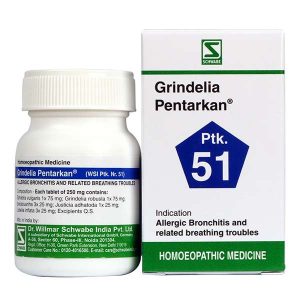
Allergic bronchitis
-
-18%
 Rated 4.20 out of 5 based on 5 customer ratings(5)
Rated 4.20 out of 5 based on 5 customer ratings(5)₹195.00₹159.90 You Save: ₹35.10 (18%)Add to cart
Showing the single result
Bronchitis is an inflammation in the lining of the air pathway including the nose, bronchial tubes, lungs. Specifically, the swelling in the lining of the bronchial tube is characterized as bronchitis. The swelling in the airway narrows the pathway causing a cough and breathing difficulty. The irritation may lead to the production of mucus, which further blocks the narrowed airway. Bronchitis is generally classified as allergic, non-allergic, or asthmatic.
Allergic bronchitis: The inflammation of bronchial tubes occurs due to allergen or something allergic that irritates the lining along the airways is called allergic bronchitis.
Pollen, dust, smoke, and mold, are airway irritants that can trigger symptoms. The symptoms of allergic bronchitis may occur all of sudden or may last for a long time or keep recurring. Allergic bronchitis lasting longer more than three months is called chronic bronchitis like in chronic obstructive pulmonary disease (COPD). In chronic bronchitis, cigarette smoking is the most common irritant.
- Common symptoms of allergic bronchitis include
- Shortness of breath
- Wheezing
- Cough
- Excess mucus production in chest
- Chest tightness
- Tiredness
Complications of allergic bronchitis
Dyspnea is the foremost complication experienced in severe cases of allergic bronchitis. The swelling in the airways can also lead to complications like lung infection. The most common lung infection is pneumonia. Often, when pneumonia progresses can lead to septicemia. Septicemia is the infection of the bloodstream. It may be life-threatening. other complications include pneumothorax, polycythemia, emphysema, respiratory failure, cor pulmonale (alteration in the structure of the heart, mostly in the right ventricle).
CAUSES are common irritants like:
- Tobacco smoke
- Environmental pollution
- Allergens such as pollen, mold, smoke, dust, pet dander, or food (and food additives like MSG)
- Chemical toxins
- Certain medications (aspirin, beta-blockers)
- Exercise
- Weather changes (extreme weather changes cold or hot)
- Infections: fungal, viral, and bacterial
- Vigorous emotions (laughing or crying)
Non-allergic bronchitis
In cases where bronchitis occurs because of infection may be viral or bacterial is called allergic bronchitis. Non-allergic bronchitis may occur after exposure to a cold or after catching a cold.
Anyone is susceptible to non-allergic bronchitis, but older adults and people with weak immunity are at a higher risk of experiencing upper airway infections including bronchitis. Non-allergic bronchitis is often an acute condition and subsides with a few days to a weak therefore its is called acute bronchitis. The common symptoms of non-allergic bronchitis may include a cough that produces mucus, chills, and fever.
Diagnosis: If you are experiencing symptoms of allergic bronchitis like breathing difficulty with fever, pain, and tightness in the chest it is important to visit your doctor. The doctor will review a complete but individual-based medical history. A physical examination may also be performed before ordering some lab tests. A few questions will be asked to determine the state of your disease according to symptoms that have been occurring and causing discomfort. Following lab tests may be advised by your doctor:
- Spirometry. this test helps to measure the lung function as you inhale and exhale out of a mouthpiece attached to a spirometer.
- Peak expiratory flow. This test measures the force of the air you exhale into the mouthpiece called a peak expiratory flow meter.
- Chest X-ray. It is a radiology test that produces images of the chest. The images help the doctor to look for evidence of other conditions causing breathing problems and cough. It also helps to rule out a condition like pneumonia, TB.
- Blood test: It will help to determine if an infection is present or not.
- A pulmonary function test may also be advised along with spirometry to determine the functioning of the lungs.
Treatment for allergic bronchitis may include the following:
Bronchodilators relax the muscles around the airways. Bronchodilators help to dilate or widen the airways and make breathing easier. Both short-acting and long-acting bronchodilators are available in the market. Steroids, mucolytic drugs are often used to treat allergic bronchitis. In some cases of allergic bronchitis symptoms become so severe that oxygen supply to the airways is hindered. In such cases, oxygen therapy can help to restore the normal levels of oxygen.
Immediate treatment in sudden and severe cases is a must. Such cases can turn out fatal. For immediate treatment, a prescription is necessary. If an individual is suffering from symptoms of allergic bronchitis some home remedies can help to reduce the effects. Although it will not cure but bring down discomfort due to this disease. Home remedies like a humidifier to moisten the air and loosen mucus. Using a humidifier will make it easier to expel the air out of the lungs. Wheezing will decrease. People with asthma and severe allergic bronchitis should check with their health professional before using a humidifier.
Drinking plenty of fluids and juices. This will thin out the mucus stuck stubbornly in the airways.
Gargle with saltwater or lukewarm water. This will reduce the discomfort and provide soothing effects to the irritated lining of the throat and lungs.
Prevention methods include avoiding anything that irritates and riles the lining of the airways. It also means to abstain from all those things that you are allergic to. Outdoor allergens including dust, pollen, fumes, air pollutants, chemicals, pet dander are the things you need to avoid. You can wear a mask while going out or avoiding the trip to places full of these allergens. Abstaining from cigarette smoke, or not starting at all, is the best way to prevent the condition.
Homeopathic medicines are safe to use. This mode of treatment can be used individually or along with the conventional treatment methods for better results.
Homeopathic treatment for allergic bronchitis:
Ephedra vulgaris: Its main action is on the mucous membranes of the bronchioles. This homeopathic medicine is mostly used as a decongestant in cases of mucus build-up in the lungs and bronchi. It helps in the expectoration of the mucous. This medicine will help ease the dyspnoeic spell by relaxing the narrowed airways.
Grindelia robusta: It is extensively indicated in cases for bronchial asthma and chronic bronchitis. Breathing difficulty with mucous rales and wheezing are improved with the action of this homeopathic medicine. Viscus mucous build-up in the chest can cause oppression. Such conditions can also be cleared with Grindelia robusta
Ipecacuanha: In cases of allergic bronchitis with spells of irritating spasmodic cough with symptoms of nausea and vomiting are ameliorated with this particular medicine. Excellent results are found in the treatment of constriction in the chest, bronchial asthma, and dyspnoea. Its action covers coughing, attacks of difficult breathing, bubbling rales, coryza, and whooping cough. It can also be thought in cases of incessant cough with every breath
Justicia adhatoda: It is a very good remedy for the disease of the respiratory system. It provides a first-class relief in infection of the upper respiratory tract. Symptoms of the common cold including sore throat, titillating cough are cured with the help of few doses. It also provides relief from dry cough, coughing with sneezing and tightness across the chest. It can be thought in cases of severe dyspnoea and paroxysmal cough with asthmatic attacks.
Lobelia inflata: It allays dyspnoea from constriction of the chest. It is found indicated in useful during acute attacks of bronchial infection and asthma. It ameliorates spasmodic cough accompanied by nausea, vomiting, and sweating.
Blog Post


Effects of Diabetes, Smoking, and Other Factors on Sexual Health


Plant-based Protein vs. Animal Protein: Which is Better for Your Health?




























